Logistics, complications and weather: Making the 2020 London Marathon run smoothly

CTV Outside Broadcasts, Broadcast RF and Aerial Camera Systems capturing the men’s elite action at the 2020 London Marathon for BBC Sport
The 2020 London Marathon was a vastly different affair to those of previous years, both for the runners and for those of us watching from the comfort of our sofas at home.
Those thousands of runners, the amusing and cumbersome costumes, and huge crowds cheering the athletes onwards past the capital’s major landmarks were absent for 2020 due to coronavirus restrictions.
Instead, only elite athletes ran the 2020 race, which took place on Sunday 4 October after its postponement from Sunday 26 April, winding in a closed-loop circuit around St James’s Park in central London, with the iconic finish on The Mall remaining the same as in previous years. The men’s winner was Shura Kitata of Ethiopia with a time of 2:05:41, and the women’s elite winner was Brigid Kosgei of Kenya, who went across the finish line in 2:18:58. Meanwhile, the elite wheelchair races were won by Canadian Brent Lakatos, and Dutch Nikita den Boer.
Logistical challenge
You might think that broadcasting a race held in a relatively compact space would be simpler than in previous years. However, for BBC Sport, CTV Outside Broadcasts (CTV OB) and its fellow Euro Media Group (EMG) companies, Broadcast RF and Aerial Camera Systems (ACS), it was far from simple.
Explains Greg Livermore, CTV OB unit manager: “The marathon is a logistical challenge, not a technological one. Despite the fact that it is on air for just a few hours on one day of the year, it is impressively complicated from our point of view.
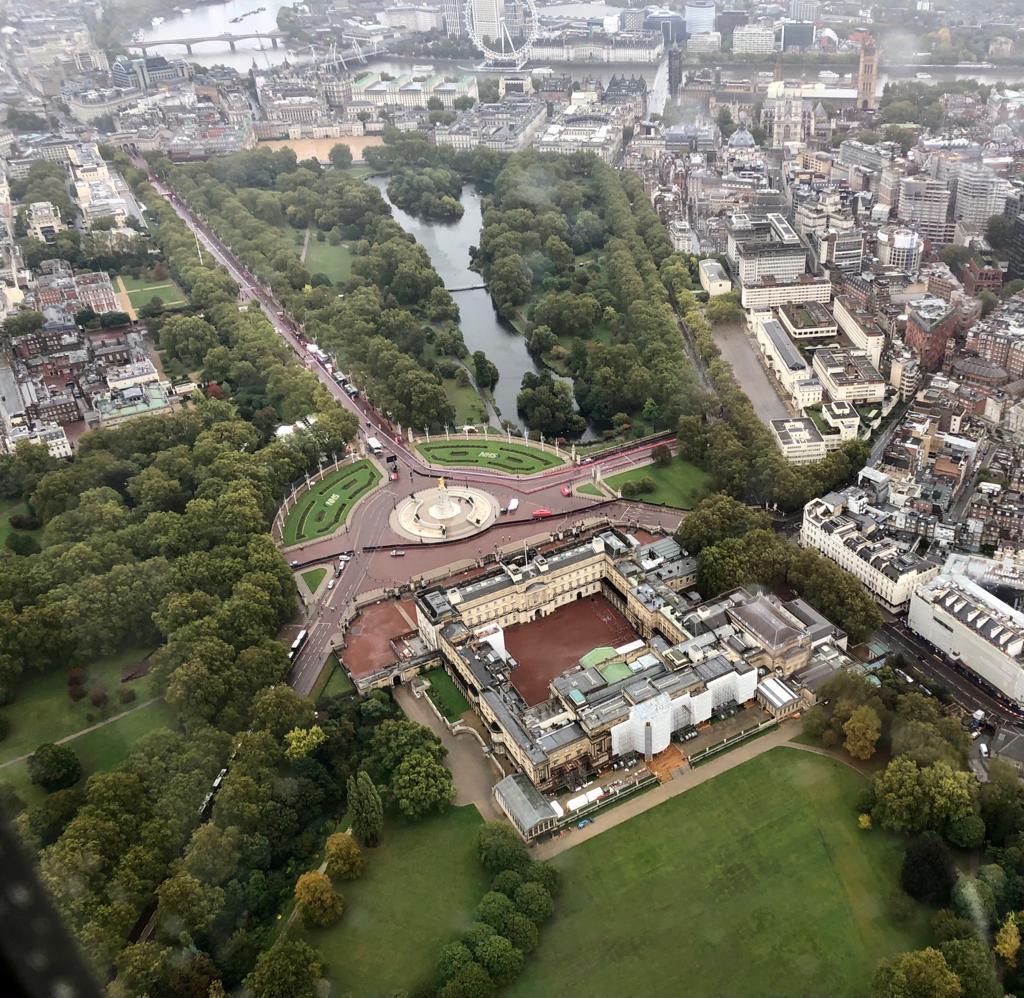
This year’s London Marathon took place in St James Park, the Queen’s back garden
“Outside of the complex RF setup for the radio cameras, we use tried and tested technology in the acquisition of the programme,” Livermore continues. “The difficult part is the coordination. The success of the broadcast is dependent on collaborative planning between London Marathon Events and the broadcast side of the Marathon; CTV OB and BBC Sport. We work hard together on pinning down the timings, movements, signage and logistics.”
Continues Livermore: “You can bring all the technology you like to a show, but if you have the logistics wrong then you won’t have the space, time or support to get it working. With all of the planning, coordination and two days of technical rigging that occurred before the event, the day of the Marathon went without a single technical glitch, despite the horrendous weather.”
For Broadcast RF the biggest challenge in the days leading up to the event was that, “it was all new,” Nick Fuller, RF project manager for Broadcast RF and Marathon and large event veteran, tells SVG Europe. “This included a new course and course layout, which effectively amounted to a new event, certainly a new schedule of races, with three back to back marathons, and a new location for the OB compound,” he continued.
Fuller notes that as well as the new course, COVID restrictions added to the complications for everyone involved: “The event organisers had their own problems with the exact course, start and finish line positions, let alone all the COVID implications, which led to many last minute changes in the design of the course with knock-ons for both the broadcaster and the technical facilities providers.
“We had weekly video-conferencing calls involving the event organisers, BBC, CTV OB and Broadcast RF to discuss the details, and during race week these calls became daily, essential for those last minute updates,” he adds.
“With the rain refusing to let up for virtually the whole weekend, the working conditions were less than ideal for the rig and test days, as well as for the event day on Sunday. But this is what outside broadcasts are all about; if the event can go ahead despite the weather, we have to cover it”
The races were held in a secure biosphere as has been the case with other major sporting events. As far as COVID-19 protocols are concerned, the crews are now well used to what is required of them, while vehicles have been health and safety compliant for some time. Explains Livermore: “COVID-19 poses little in terms of an onsite challenge to outside broadcasts now. We adapted the trucks at an early stage and all crew are used to the mask wearing, social distancing aspect of infection prevention.”
Speaking to SVG Europe, Micky Payne, BBC producer and director, and the London Marathon’s planning and race producer, adds: “The COVID pandemic was an obvious issue in terms of practicalities, but we worked closely with the race organisers about testing for all crew and safety procedures in terms of social distancing between cameras and athletes, and the wearing of masks for interviews.”
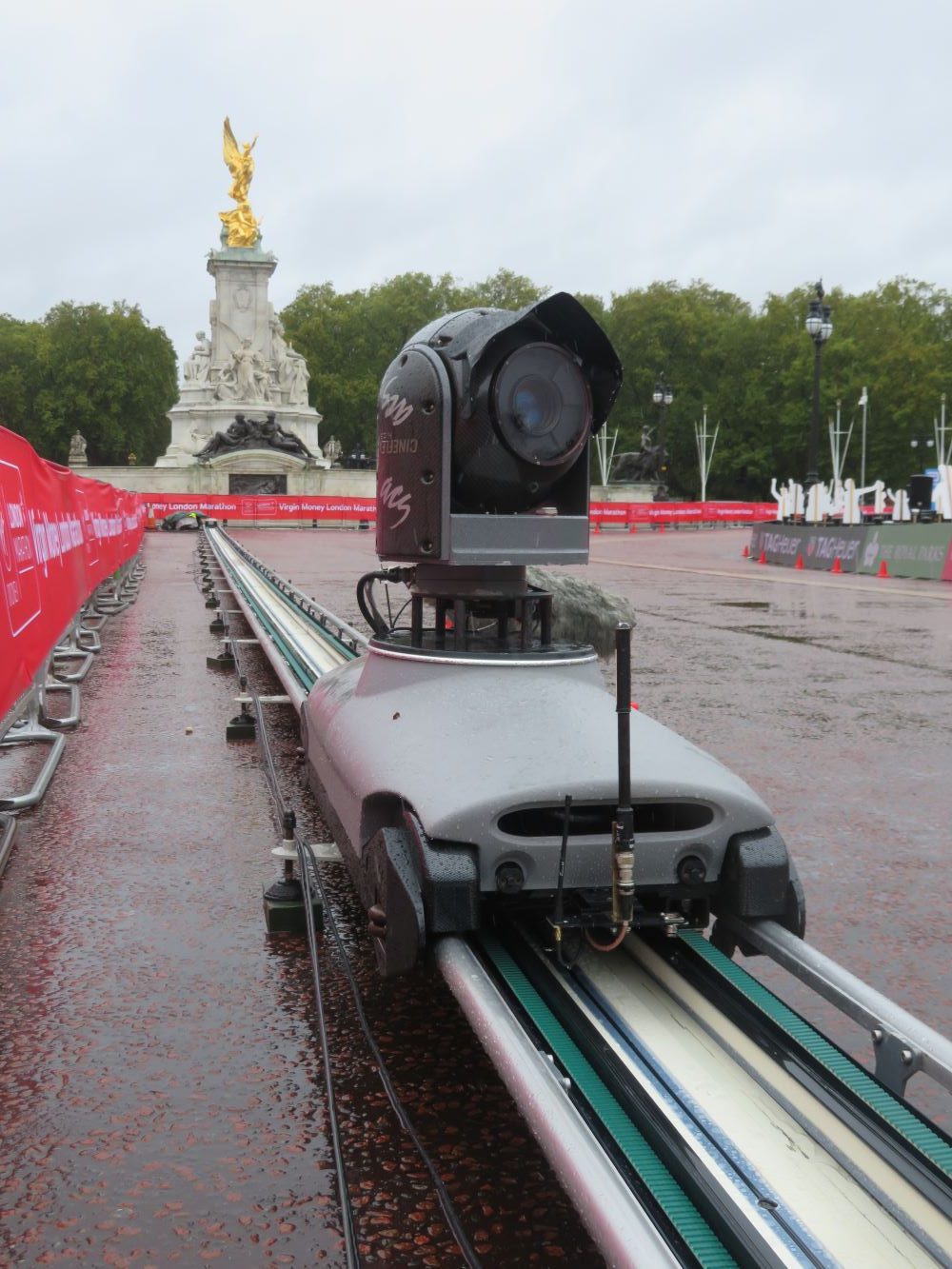
Speeding along the track with Aerial Camera Systems
Extra toys for broadcast
From a director’s point of view, bringing broadcast partners’ technologies into play this year was key in making this extremely different coverage from the ‘usual’ London Marathon work. Payne says: “The 2km lap course made it vital to have quite a few extra ‘toys’ on the course to help avoid the race coverage being dull. So we had two railcameras, several jib and hoist cameras, as well as the usual bike and helicopter cameras, to boost the images. We also had a kart camera (a remote controlled low-level mobile camera,) and a drone camera, but both were unable to work safely because of the wet weather.”
He adds: “The landmarks of Buckingham Palace, the Royal Parks and Horse Guards Parade all needed to be reflected as normal as part of this iconic event.”
The BBC used separate OB trucks for the race and transmission. Both trucks had directors and producers/editors, production coordinators, VT producers, plus an overall production manager to oversee the logistics and budget. In addition, the BBC had one on-site edit suite and producer.
There were two large CTV OB Scanners onsite with a large SES Events truck providing the space for the graphics and timing operation, and over 100 crew onsite for CTV OB, including staff and contractors. “We have a total number of 28 vehicles onsite including generators, camera hoists, tenders etc,” says Livermore.
Adds Payne: “We also had three floor managers – with commentary, presenter and reporter – to help link the OB trucks with the event. And we had four commentators across the three races. Graphics provided four more operators, working to race and transmission, including a dedicated operator and producer for social media messaging.”
The race was live on the BBC from 7:00am to 3:20pm. The coverage was split between BBC1 and BBC2, and CTV OB also provided a Race Feed that was used by international takers. Presenter Gabby Logan was onsite, heading up the eight hours coverage from her presentation position. She was supported by reporters, Jeanette Kwakye and Radzi Chinyanganya.
Complicated rig solutions
Says Livermore: “Working in the Queens front garden always poses challenges. Until the site locks down, we are working alongside the general public. We spent three days rigging this event, with a compound and cable rig starting on Thursday. We then continued the build on Friday and Saturday morning, with a production rehearsal on Saturday afternoon.”
Notes Fuller: “With the rain refusing to let up for virtually the whole weekend, the working conditions were less than ideal for the rig and test days, as well as for the event day on Sunday. But this is what outside broadcasts are all about; if the event can go ahead despite the weather, we have to cover it.”
CTV laid 16,000m of cable plus 180m of ADA cable ramp around the course to facilitate the various cameras and radio receive points. Says Livermore: “St James’ park is a deceptively large area, which has remained open to the public during the entire rig and event. The skill of the riggers, under foreman Gary Scott, in getting this cable rigged in a short period of time in a difficult site in terrible weather is something that should not be overlooked.”
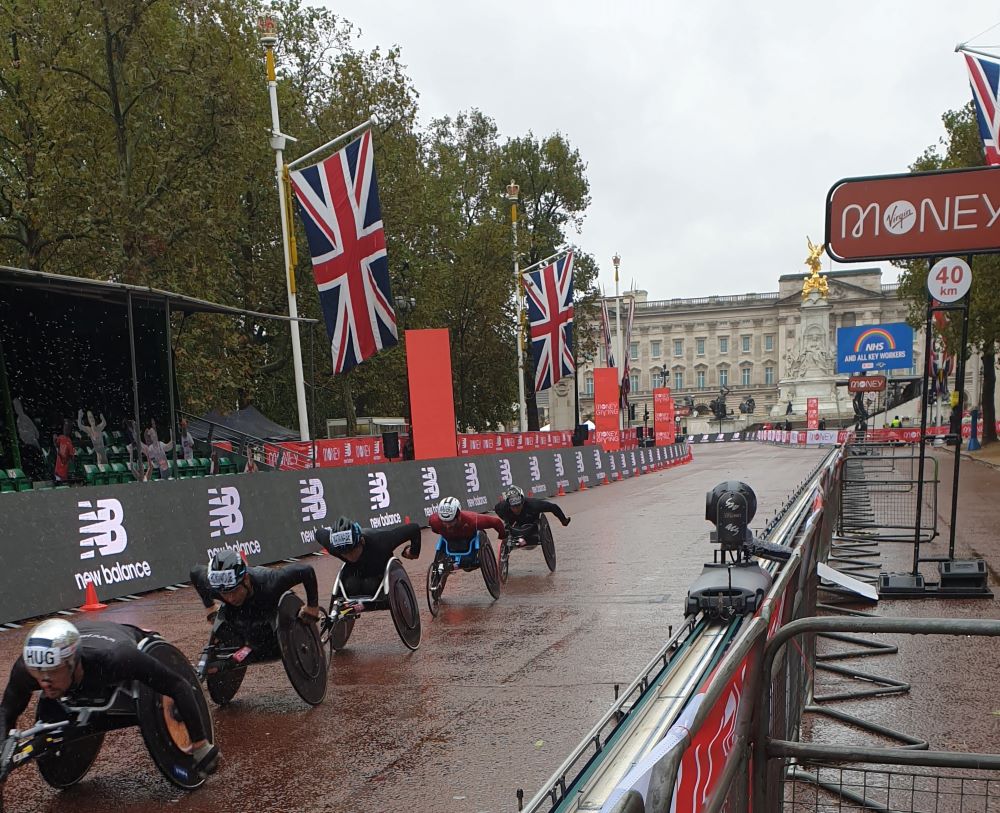
The London Marathon 2020 men’s wheelchair elite race was won by Brent Lakatos
Due to the course consisting of twenty 2.1km laps around St James’ Park rather than the long course across London, Broadcast RF employed a radically different technical solution from usual for the mobile RF cameras on bikes and in helicopters.
Motocam was contracted by Broadcast RF to provide four all-electric motorbikes to use as mobile camera platforms, with two deployed on each of the three races (Women’s Elite, Men’s Elite and Elite Wheelchairs).
The bikes come with experienced pilots, used to a variety of different courses, so this new short course was no problem for them despite the slippery conditions.
Arena Aviation was also contracted by Broadcast RF to provide two helicopter camera ships, including gyro-stabilised cameras. “As usual they also organised a temporary refuelling site close to the course, saving time and fuel on the day and providing a better chance of being able to fly should the weather close in, which it did,” laughs Fuller.
Rather than relaying signals via a fixed wing aircraft circling along the course at 25000ft, which is the usual method, a ground-based reception system was engineered. This consisted of eight receive antennas located at the four ‘corners’ of the course, providing full coverage of the links from the camera bikes, plus a 70m tall hoist supported the receive antennas for the helicopters.
“All these antennas were connected back to switching systems, based in the OB compound, via fibre-optic cables. The automatic switching was designed to provide seamless pictures from these mobile cameras,” says Fuller.
In total Broadcast RF provided RF links for 15 out of the 23 cameras deployed on the event including two RF rail-cams, five handheld roving cameras, a drone and a remote control kart camera, all of which, “kept the on-site RF crew extremely busy,” notes Fuller.
He adds: “These links also relied on fibres to get the signals from the receive antennas back to the OB, but delays in the installation of the course infrastructure meant the full complement of fibre cables were not in place until late on Saturday [3 October]. This meant only a very limited period for testing before the first race started at 7:30am on Sunday morning.”
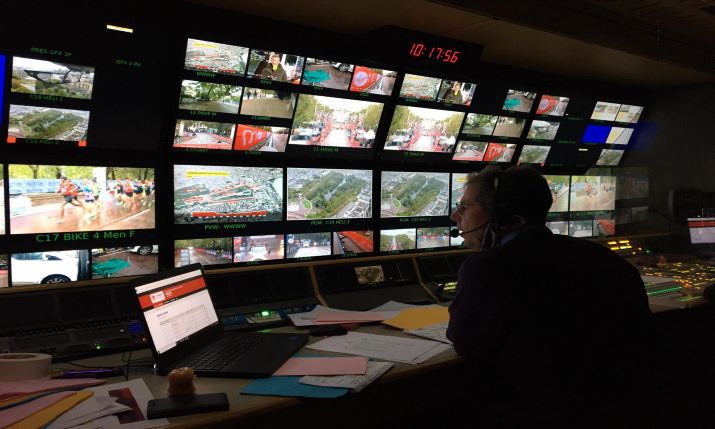
Hard at work in CTV OB’s truck
Capturing athletes
Meanwhile, ACS provided a Smarthead with Sony P1 rigged at the finish line to capture the athletes approaching and a 125m Railcam fitted with a Cineflex V14 stabilised mount down The Mall, tracking the final sprint to the finish. Both provisions have been regularly used for the Marathon coverage.
New for 2020 was an ACS railcam with a Cineflex V14 stabilised mount running 140m along Spur Road, following the athletes running down Birdcage Walk, turning towards the Queen Victoria Memorial in front of Buckingham Palace, and onto the final corner at the beginning of the Mall.
Says ACS head of tracks, Malcolm Rogers: “This particular addition has been something ACS have been discussing with the BBC for a few years now, and the alternative course configuration for this year gave them the opportunity to demonstrate it with some great results.”
Rogers explains: “As there was no public this year the mindset changed; it was a very different event from previous years. For our track crew it was a new way of working to what we have historically done on the Marathon.
“Ordinarily, on the finish line rail for The Mall, our track is placed at height to sit over the advertising boards. As it was only the elite runners competing, we were able to bring the track much closer to the middle of the Mall with a lower lens height so the positioning and shot was similar to an athletics track event; something we’re very experienced at delivering. We also had 19 goes at the shot on each race before our two tracks took over the coverage for the final 300m to the finish line when the bike coverage peels away.”
He continues: “We’ve worked very closely with CTV, the BBC and the London Marathon throughout the years and are able to have open discussions on placement of kit and crew and any security challenges making delivery on site very straightforward. The main challenge for ACS was this new position, having never done it before, but we have always been confident it would be an added benefit to the production.”
Rogers concludes: “Aside from all crew onsite dealing with the COVID regulations, the main challenge on the day was the weather; it only stopped raining for two hours during the three days we were there!”
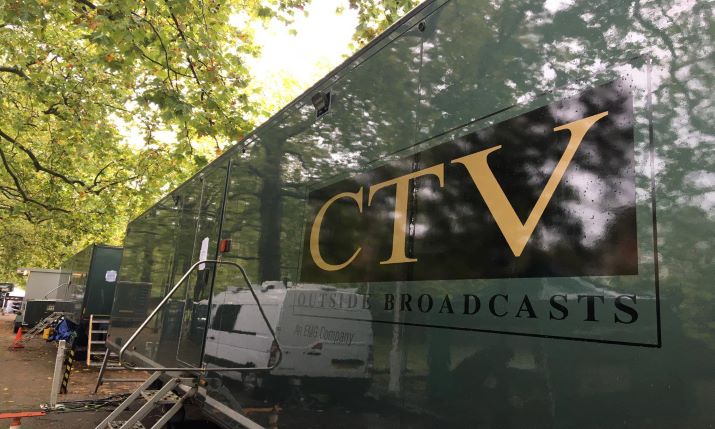 Virtual runners and atmosphere
Virtual runners and atmosphere
For BBC Sport, one of the biggest challenges in pulling this event together was showing all the London Marathon virtual runners on screen. Explains Payne: “Editorially, reflecting the mass element of the event, which all happened virtually and remotely with over 35,000 people expected to finish their own official London Marathon in their own area, was a challenge.
“The elite races are important, but the human aspect of mass participation for charitable and personal reasons is huge, and to reflect that via ‘zoom’ type technology was a big element,” Payne notes.
There were a number of second screen innovations this year, including a marathon virtual wall where participants taking part in their own virtual marathon in their own areas could join in and become part of the feed that went out to various screens around the course, and onto the BBC programme and Red Button. This was hosted in the graphics truck by Happy Graphics.
To generate atmosphere, tension and excitement from an audio point of view, to balance the lack of crowds of spectators and to relieve the repetitive circuit run by the elite athletes, some special FX were used by the BBC.
States Payne: “We had no enhanced audio in the way that many football leagues have used it, but we did still have the event PA system to mix in with commentary, plus some natural FX from previous London Marathons to help boost the natural sound available. It is also important for the commentators to have something to talk against.”
Mammoth Graphics provided start lists, timing and results graphics to the World Feed as well as presentation and social media graphics for the BBC. There were four graphics outputs available to production so that all three races were covered start to finish for the World Feed, BBC Red Button, as well as the interaction with the public which is such a feature of the event and was also covered for BBC One and BBC Two.
Finally, Mika Timing alongside Netventure delivered data to Mammoth’s four on-site Vizrt machines. Netventure took Mika Timing’s data and pushed it to various Mammoth-designed Viz templates that showed the time of every mile run, a constantly updating leaderboard, the time elapsed, and race positions at certain distances (eg 5km, 10km etc).
While the day went off smoothly, here’s hoping that the London Marathon 2021 will be back to its former epic glory.
The 2020 London Marathon took place on Sunday 4 October.
